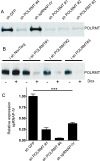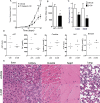Targeting mitochondrial RNA polymerase in acute myeloid leukemia
- PMID: 26484416
- PMCID: PMC4741925
- DOI: 10.18632/oncotarget.6129
Targeting mitochondrial RNA polymerase in acute myeloid leukemia
Abstract
Acute myeloid leukemia (AML) cells have high oxidative phosphorylation and mitochondrial mass and low respiratory chain spare reserve capacity. We reasoned that targeting the mitochondrial RNA polymerase (POLRMT), which indirectly controls oxidative phosphorylation, represents a therapeutic strategy for AML. POLRMT-knockdown OCI-AML2 cells exhibited decreased mitochondrial gene expression, decreased levels of assembled complex I, decreased levels of mitochondrially-encoded Cox-II and decreased oxidative phosphorylation. POLRMT-knockdown cells exhibited an increase in complex II of the electron transport chain, a complex comprised entirely of subunits encoded by nuclear genes, and POLRMT-knockdown cells were resistant to a complex II inhibitor theonyltrifluoroacetone. POLRMT-knockdown cells showed a prominent increase in cell death. Treatment of OCI-AML2 cells with 10-50 µM 2-C-methyladenosine (2-CM), a chain terminator of mitochondrial transcription, reduced mitochondrial gene expression and oxidative phosphorylation, and increased cell death in a concentration-dependent manner. Treatment of normal human hematopoietic cells with 2-CM at concentrations of up to 100 µMdid not alter clonogenic growth, suggesting a therapeutic window. In an OCI-AML2 xenograft model, treatment with 2-CM (70 mg/kg, i.p., daily) decreased the volume and mass of tumours to half that of vehicle controls. 2-CM did not cause toxicity to major organs. Overall, our results in a preclinical model contribute to the functional validation of the utility of targeting the mitochondrial RNA polymerase as a therapeutic strategy for AML.
Keywords: acute myeloid leukemia; electron transport chain; mitochondria; mitochondrial RNA polymerase; oxidative phosphorylation.
Conflict of interest statement
The authors disclose no potential conflicts of interest.
Figures





References
-
- Skrtic M, Sriskanthadevan S, Jhas B, Gebbia M, Wang X, Wang Z, Hurren R, Jitkova Y, Gronda M, Maclean N, Lai CK, Eberhard Y, Bartoszko J, Spagnuolo P, Rutledge AC, Datti A, et al. Inhibition of Mitochondrial Translation as a Therapeutic Strategy for Human Acute Myeloid Leukemia. Cancer Cell. 2011;20(5):674–688. - PMC - PubMed
-
- Caro P, Kishan AU, Norberg E, Stanley IA, Chapuy B, Ficarro SB, Polak K, Tondera D, Gounarides J, Yin H, Zhou F, Green MR, Chen L, Monti S, Marto JA, Shipp MA, et al. Metabolic signatures uncover distinct targets in molecular subsets of diffuse large B cell lymphoma. Cancer Cell. 2012;22(4):547–560. - PMC - PubMed
-
- Lagadinou ED, Sach A, Callahan K, Rossi RM, Neering SJ, Minhajuddin M, Ashton JM, Pei S, Grose V, O'Dwyer KM, Liesveld JL, Brookes PS, Becker MW, Jordan CT. BCL-2 Inhibition Targets Oxidative Phosphorylation and Selectively Eradicates Quiescent Human Leukemia Stem Cells. Cell Stem Cell. 2013;12(3):329–341. - PMC - PubMed
-
- Leonard JV, Schapira AH. Mitochondrial respiratory chain disorders I: mitochondrial DNA defects. Lancet. 2000;355(9200):299–304. - PubMed
Publication types
MeSH terms
Substances
LinkOut - more resources
Full Text Sources
Other Literature Sources
Medical
Research Materials

